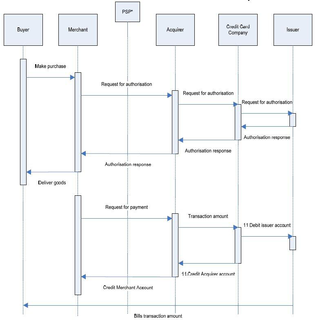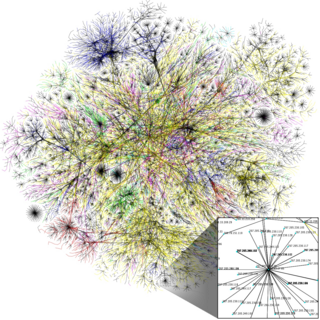E-commerce is the activity of buying or selling of products on online services or over the Internet. Electronic commerce draws on technologies such as mobile commerce, electronic funds transfer, supply chain management, Internet marketing, online transaction processing, electronic data interchange (EDI), inventory management systems, and automated data collection systems.

Instant messaging (IM) technology is a type of online chat that offers real-time text transmission over the Internet. A LAN messenger operates in a similar way over a local area network. Short messages are typically transmitted between two parties, when each user chooses to complete a thought and select "send". Some IM applications can use push technology to provide real-time text, which transmits messages character by character, as they are composed. More advanced instant messaging can add file transfer, clickable hyperlinks, Voice over IP, or video chat.
Being in escrow is a contractual arrangement in which a third party receives and disburses money or property for the primary transacting parties, most generally, used with plentiful terms that conduct the rightful actions that follow. The disbursement is dependent on conditions agreed to by the transacting parties. Examples include an account established by a broker for holding funds on behalf of the broker's principal or some other person until the consummation or termination of a transaction; or, a trust account held in the borrower's name to pay obligations such as property taxes and insurance premiums. The word derives from the Old French word escroue, meaning a scrap of paper or a scroll of parchment; this indicated the deed that a third party held until a transaction was completed.
Online Business or e-business is any kind of business or commercial transaction that includes sharing information across the internet. Commerce constitutes the exchange of products and services between businesses, groups and individuals and can be seen as one of the essential activities of any business. Electronic commerce focuses on the use of ICT to enable the external activities and relationships of the business with individuals, groups and other businesses, while e-business refers to business with help of the internet. The term "e-business" was coined by IBM's marketing and Internet team in 1996.

Accounts payable (AP) is money owed by a business to its suppliers shown as a liability on a company's balance sheet. It is distinct from notes payable liabilities, which are debts created by formal legal instrument documents.
An intermediary is a third party that offers intermediation services between two parties.
Online banking, also known as internet banking, is an electronic payment system that enables customers of a bank or other financial institution to conduct a range of financial transactions through the financial institution's website. The online banking system will typically connect to or be part of the core banking system operated by a bank and is in contrast to branch banking which was the traditional way customers accessed banking services.
Online shopping is a form of electronic commerce which allows consumers to directly buy goods or services from a seller over the Internet using a web browser. Consumers find a product of interest by visiting the website of the retailer directly or by searching among alternative vendors using a shopping search engine, which displays the same product's availability and pricing at different e-retailers. As of 2016, customers can shop online using a range of different computers and devices, including desktop computers, laptops, tablet computers and smartphones.
An e-commerce payment system facilitates the acceptance of electronic payment for online transactions. Also known as a sample of Electronic Data Interchange (EDI), e-commerce payment systems have become increasingly popular due to the widespread use of the internet-based shopping and banking.
Enterprise content management (ECM) extends the concept of content management by adding a time line for each content item and possibly enforcing processes for the creation, approval and distribution of them. Systems that implement ECM generally provide a secure repository for managed items, be they analog or digital, that indexes them. They also include one or more methods for importing content to bring new items under management and several presentation methods to make items available for use.
A payment system is any system used to settle financial transactions through the transfer of monetary value, and includes the institutions, instruments, people, rules, procedures, standards, and technologies that make such an exchange possible. A common type of payment system is the operational network that links bank accounts and provides for monetary exchange using bank deposits.

A voucher is a bond of the redeemable transaction type which is worth a certain monetary value and which may be spent only for specific reasons or on specific goods. Examples include housing, travel, and food vouchers. The term voucher is also a synonym for receipt and is often used to refer to receipts used as evidence of, for example, the declaration that a service has been performed or that an expenditure has been made. Voucher is a tourist guide for using services with a guarantee of payment by the agency.
Electronic governance or e-governance is the application of information and communication technology (ICT) for delivering government services, exchange of information, communication transactions, integration of various stand-alone systems and services between government-to-citizen (G2C), government-to-business (G2B), government-to-government (G2G), government-to-employees (G2E) as well as back-office processes and interactions within the entire government framework. Through e-governance, government services are made available to citizens in a convenient, efficient, and transparent manner. The three main target groups that can be distinguished in governance concepts are government, citizens, and businesses/interest groups. In e-governance, there are no distinct boundaries.
In online marketing, a shopping cart is a piece of e-commerce software on a web server that allows visitors to an Internet site to select items for eventual purchase, analogous to the American English term "shopping cart." In British English, it is generally known as a shopping basket, almost exclusively shortened on websites to "basket."
Web-to-print, also known as Web2Print, remote publishing or print e-commerce is commercial printing using web sites. Companies and software solutions that deal in web-to-print use standard e-commerce and online services like hosting, website design, and cross medial marketing.
Business-to-employee (B2E) electronic commerce uses an intrabusiness network which allows companies to provide products and/or services to their employees. Typically, companies use B2E networks to automate employee-related corporate processes. B2E portals have to be compelling to the people who use them. Companies are competing for eyeballs of their employees with eBay, yahoo and thousands of other web sites. There is a huge percentage of traffic to consumer web sites comes from people who are connecting to the net at the office.
Alternative payments refers to payment methods that are used as an alternative to credit card payments. Most alternative payment methods address a domestic economy or have been specifically developed for electronic commerce and the payment systems are generally supported and operated by local banks. Each alternative payment method has its own unique application and settlement process, language and currency support, and is subject to domestic rules and regulations.

Electronic commerce, commonly known as e-commerce or eCommerce, or e-business consists of the buying and selling of products or services over electronic systems such as the Internet and other computer networks. The amount of trade conducted electronically has grown extraordinarily with widespread Internet usage. The use of commerce is conducted in this way, spurring and drawing on innovations in electronic funds transfer, supply chain management, Internet marketing, online transaction processing, electronic data interchange (EDI), inventory management systems, and automated data collection systems. Modern electronic commerce typically uses the World Wide Web at least at some point in the transaction's lifecycle, although it can encompass a wider range of technologies such as e-mail as well.




